
Hindawi Publishing Corporation
EURASIP Journal on Advances in Signal Processing
Volume 2011, Article ID 538314, 10 pages
doi:10.1155/2011/538314
Research Article
Selection of Nonstationary Dynamic Features for
Obstructive Sleep Apnoea Detection in Children
L. M. Sepulveda-Cano,1E. Gil,2P. L a g u n a , 2and G. Castellanos-Dominguez1
1Grupo de Procesamiento y Reconocimiento de Se˜naales, Universidad Nacional de Colombia, Km. 9, V´ıa al Aeropuerto,
Campus La Nubia, 17001000 Manizales, Colombia
2Communications Technology Group (GTC), Arag´on Institute of Engineering Research (I3A), ISS, University of Zaragoza, CIBER-BBN,
Mar´ıa de Luna 1, 50018 Zaragoza, Spain
Correspondence should be addressed to L. M. Sepulveda-Cano, lmsepulvedac@bt.unal.edu.co
Received 1 July 2010; Revised 6 December 2010; Accepted 26 January 2011
Academic Editor: Antonio Napolitano
Copyright © 2011 L. M. Sepulveda-Cano et al. This is an open access article distributed under the Creative Commons Attribution
License, which permits unrestricted use, distribution, and reproduction in any medium, provided the original work is properly
cited.
This paper discusses the methodology for selecting a set of relevant nonstationary features to increase the specificity
of the obstructive sleep apnea detector. Dynamic features are extracted from time-evolving spectral representation of
photoplethysmography envelope recordings. In this regard, a time-evolving version of the standard linear multivariate
decomposition is discussed to perform stochastic dimensionality reduction. For training aim, this work analyzes the concrete
set comprising filter banked dynamic features that include spectral centroids, the cepstral coefficients as well as their time-
variant energies. Performance of classifier accuracy is provided for the collected polysomnography recordings of 21 children.
Moreover, since the apnea diagnosing is based on analysis of set of fragments partitioned from the photoplethysmography envelope
recordings, a new approach for their indirect labeling is described. As a result, performed outcomes of accuracy bring enough
evidence that if using a subset of cepstral-based dynamic features, then patient classification accuracy can reach as much as 83.3%
value, when using a k-nn classifier, as well. Therefore, photoplethysmography-based detection provides an adequate scheme for
obstructive sleep apnea diagnosis.
1. Introduction
Regarding the diagnosis of obstructive sleep apnea (OSA)
syndrome, which is characterized by recurrent airflow
obstruction caused by total or partial collapse of the upper
airway, several strategies have been developed to decrease the
number of the sleep recordings needed for usually performed
polysomnography [1] that is related as an expensive and
time-consuming procedure. One promising alternative is
the pulse photoplethysmography signal (PPG) that is a
simple, but useful, method for measuring the pulsatile
component of the heartbeat. PPG measurement evaluates
peripheral circulation, and is tie related either to arterial
vasoconstriction or vasodilatation generated by the auto-
nomic nervous system, being modulated by the heart cycle.
Furthermore, automatic detection of time-variant decreases
in the amplitude fluctuations of PPG have shown their utility
for OSA diagnosis [2–4].
Nonetheless, since there is a large number of situation
when PPG enveloped is affected independently of the apnoea
status,then,alowratiosensitivity/specificityisaccom-
plished. Therefore, to better discriminate between apnoea
from other PPG envelop alterations an improved set of rep-
resenting features should be taken into account, particularly,
stochastic modeling of dynamic features for OSA detection is
to be further considered in this work.
The use of stochastic modeling, when taking into
account evolution of random biological variables along time
(herein referred as dynamic features) precedes the necessity
of building a proper methodology of their processing.
Furthermore, it is well known that the complexity of
stochastic modeling increases because of need to carry out

2 EURASIP Journal on Advances in Signal Processing
the adequate nonstationary estimation of parameters derived
from biosignal recordings. One can refer to that issue as
the most important difference between static and dynamic
statistical processing.
As a rule, methodology for analysis of time series is
based on the assumption that there is always a processing
time window of such a length that the piecewise stationary-
based approach of analysis holds. Although determination
of proper stationary data length remains as an open issue.
With this in mind, the time-frequency representation (TFR)
has been proposed before for the analysis of nonstationary
biomedical data. Among the most popular TFR used to
investigate the dynamic properties of the time-evolving
spectral parameters, during either transient physiological
or pathological episodes, are those computed directly from
the raw data after preprocessing, termed nonparametric
approaches. Specifically, the Wavelet Transform (WT) and he
Short Time Fourier Transform (STFT) are commonly used.
Though the former TFR is likely to avoid the t-fresolution
compromise, the latter nonparametric approach is desirable
for biosignals with a slow time varying spectrum [5], as it
is the case for PPG recordings. However, the application of
TFR to the analysis of short transient signals (like in case
of PPG envelope) is a complex, and difficult task due to
the inherent limitations of the TFR techniques for extracting
the relevant, but not redundant characteristics. In other
words, without accurate models to describe properly the
dynamic behavior of PPG envelope biosignals, the use of
t-fprocessing methods, based on stochastic assumptions,
may fail to provide satisfactory results. In this sense, it has
been established the discriminating capability of frequency
bands of biological activity between normal and pathological
patterns, and for that reason, the set of TFR-based stochastic
features to be considered should be suitable estimated by
time-evolving spectral subband methods.
Nonetheless, the amount of measured time-variant fea-
tures can be large, no mentioning that the sampling rate
used for these measurements may be also high. Assuming
that dynamic variables are low-pass processes, then the
enclosed information within the stochastic data becomes
highly correlated. This fact provides large data-sets holding
big amount of redundancy, which in turn leads to either
overtraining data or significant increasing of computational
overhead. In such a situation, dimension reduction that
should be strongly considered might determine the adequate
number of relevant features to select either by encoding or
removing both redundant and irrelevant information. Fur-
thermore, the concept of biosignal interpretation becomes
critical, whose ultimate goal is the proper classification of the
features, but also to depict them in order to maximize correct
interpretation and physiological or clinical meaning [6].
Extraction of relevant stochastic information from
dynamic feature sets has been discussed in the past, as a
means to improve performance during and after training in
learning processes. Thus, to get an effective feature selection
algorithm, in the context of an inference, two main issues
aretobeovercame[
7]: the same measure associated to a
given relevance function (i.e., a proper measure of distance
for time series), and the multivariate transformation through
the time axis, which is assumed to maximize the measure
of relevance present in the nonstationary features by their
projection onto a new space. For a dimension reduction,
statistical latent variable techniques can be applied, for
example, by using Principal Component Analysis (PCA)
that maximizes the variability on the input data set. This
specific and unique property of PCA makes the station-
ary signals easy to interpret. But standard latent variable
techniques clearly do not take into consideration the time-
evolving nature of random biological variables, since they are
grounded on a common representation that minimizes the
global reconstruction error.
The aim of this study is to select a set of relevant
nonstationary features, extracted from t-frepresentation
of time-dependant PPG envelope signals, to increase the
specificity in the apnoea detector. This work analyzes the
set comprising filter banked dynamic features that includes
spectralcentroidsaswellasthecepstralcoefficients. Specif-
ically, a time-evolving version of the standard linear multi-
variate decomposition is discussed throughout this paper to
perform stochastic dimensionality reduction of the dynamic
features in hand. The rest of the paper is organized as
follows: Section 2 introduces materials and methods focused
on generation of nonstationary features, extracted from
t-frepresentation of time-dependant PPG envelope signals.
Also, the proposed methodology of stochastic training is
evaluated using real PPG recordings. The attained results
are discussed in Section 5. Finally, Section 6 presents the
conclusions and discusses some possibilities for future work.
2. Materials and Methods
2.1. Generation of Enhanced Dynamic Features. The PPG
envelope, y(t), is estimated based on the root mean square
series of input PPG signal, yPPG (t). So, the discrete version of
PPG envelope, after mean removal by a moving average filter,
can be written as follows [2]:
y(n)=
1
N
n
k=n−(N−1)⎛
⎝yPPG(k)−1
M
k
l=k−(M−1)
yPPG(l)⎞
⎠
2
,
(1)
where the values for the window length of the filtering, M,
and the root mean square series, N,arefixedtobe25and
twice the mean cardiac cycle, respectively.
Generally, a direct way of describing the PPG envelope,
y(t), in both time and frequency (t-f)domainsbecomesits
time-evolving spectral representation. Thus, for estimating
TFR of random signals, power spectral density is commonly
used, which for a given biosignal, y(t), is directly represented
by the spectrogram:
Syt,f=
Ty(τ)φ(τ−t)e−j2πfτdτ
2
,
t,τ∈T,Syt,f∈R+.
(2)

EURASIP Journal on Advances in Signal Processing 3
Supported on classical Fourier Transform, the Short Time
version (termed STFT) introduces a time localization con-
cept by using a tapering window function of short duration,
φ, that is, going along the studied biosignal, y(t).
Extracted from the spectrogram-based TFR, any stochas-
tic feature x(t) refers to random numeric values comprising
measures evolving over time, that is, there is a certain set of
parameters, Ξ={xi=xi(t): i=1, ...,p},thatarechanging
along the time axis, t∈T, is supposed to carry temporal
information of the nonstationary biosignals. In this regard,
some nonparametric TFR-based dynamic measures have
been widely accepted, mainly, those estimated by spectral
subband methods, when efficiently combining frequency and
magnitude information from the short-term power spec-
trum of the input biosignals. For instance, given a discrete
time series, y(n), being the sampled version of a continuous
biosignal recording y(t), the set of Linear Frequency Cepstral
Coefficients (LFCC) is proposed to be employed, which is
extracted by Discrete Cosine Transform of triangular log-
filter banks, {Fm(k): m=1, ...,nM},linearlyspacedinthe
frequency domain:
xn(l)=
nM
m=1
log(sm(l)) cosnm−1
2
π
p,(3)
where pis the number of desired LFCC features to be
considered, and sm(l) is the weighted sum of each frequency
filter response set, sm(l)=nK
k=1Sy(l,k)Fm(k), with m,l,and
kbeing the indexes for filter ordinal, time, and frequency
axes, respectively; nKstands for the number of samples in
the frequency domain. Other effective way of generating t-f-
based time-variant features is achieved through computation
of the histograms of the subband spectral centroids that are
estimated for each filter in the frequency domain, F′
m(k), by
xn(l)=nK
k=1kF′
n(k)Sγ
y(l,k)
nK
k=1F′
n(k)Sγ
y(l,k),(4)
where γis a parameter representing the dynamic range of
the spectrum that is used for computation of the centroid.
The filters F′
n(k) are linearly distributed along the spectrum.
In addition, the energy around each centroid can be also
considered as time-variant feature that for a fixed bandwidth
∆kis computed by means of
xn(l)=xn(l)+∆k
k=
xn(l)−∆k
Sy(l,k),(5)
where xn(l) is the actual value of the time-variant centroid
that is estimated by (4).
2.2. Relevance Analysis of Stochastic Features. Because of
high computational cost of stochastic feature-based training,
dimension reduction of input spaces is to be carried out,
being latent variable techniques widely used for this aim that
finds a transformation reducing p-dimensional stochastic
feature arrangement, Ξ∈Rp×T,intoq-dimensional stochas-
tic set, Z∈Rq×T,q≤p, in such a way that the data
information is maximally preserved. Besides, as the relevance
function, g∈R, the evaluation measure of transformation
is given that distinguishes variables effectively representing
the subjacent physiological phenomena, termed relevant
stochastic features.
The set of stochastic features, {xi}, is represented by the
observation assemble comprising Nobjects that are disposed
in the input observation matrix XΞ=[X1|· · ·|Xi|···|XN|].
Inturn,everyobject,denotedasXi,i=1, ...,N,
is described by the respective observation set of time-
variant arrangements, {xji ⊂Ξ,j=1, ...,p},suchthat,
Xi=[|x1i|· · ·|xji|· · ·|xpi|]⊤,Xi∈Rp×T,wherexji =
[xji(1) ···xji(t)···xji(T)] is each one of the measured
or estimated short-term features from biosignal recordings,
equally sampled evolving through the time, and being xij(t),
the jth stochastic feature for the ith object upon a concrete t
instant of time.
For the sake of simplicity, the reduction dimension is
developed when projecting by the simplest time-evolving
latent variable approach, that is, time-adapted PCA. So,
given the observation matrix, XΞ, there will be a couple of
orthonormal matrixes, U∈RN×N,V∈RpT×pT ,plusdiago-
nal matrix ΣX, as well, so that a simple linear decomposition
takes place, that is, XΞ=UΣXV⊤,whereΣX∈RpT×pT holds
first ordered qas most relevant eigenvalues of matrix XΞ,
ν1
ν2,...,
νq
νq+1,...,
νpT
0, that implies the
relevance measure to be considered. The minimum mean
squared-based error is assumed as the evaluation measure
of transformation, g(XΞ,Z)∼min E{Ξ−Z2},(where
·
2is the norm squared value, and E{·} is the is the
expectance operator), that is, maximum variance is preferred
as relevance measure, when the following estimation of
covariance matrix is carried out:
cov{XΞ}=X⊤
ΞXΞ=VΣ2
XV⊤.(6)
To make clear the contribution of each time-variant value
xij(t), expression (6) can be further extended in the form:
X⊤
ΞXΞ=
p
j=1
ν2
jVjV⊤
j,(7)
where Vjis the jth column of matrix V.
Consequently, the amount of relevance captured at every
moment tby the singular value decomposition, that is
associated to the whole set of features is assessed as the
following time-variant relevance measure:
g(XΞ,Z;t)=
q
j=1
ν2
jVj
.(8)
Therefore, the proper selection of the most relevant
stochastic features containing essential information can be
achieved if choosing the truncated set of extracted from
TFR parameters that exhibit the higher time-variant val-
ues of variance-based relevance measure. In other words,
dimension reduction is carried out by adapting in time
commonly used latent variable techniques (by example,

4 EURASIP Journal on Advances in Signal Processing
Preprocessing
Artifact removal
Partitioning
Clustering
y(t)
TFR enhancement
STFT
Sy(t,f)
Feature generation
Spectral centroids
Centroids energy
Cepstral coefficients
Ξ={xi(t)}
Feature selection by
stochastic relevance
analysis
Time/adapted PCA
g(Ξ,Z,t)
Detection
Classification
Validation
k-nn
Figure 1: Schematic representation of an automated system for OSA diagnosing from t-frepresentation of PPG envelope.
the one expressed by (6)), in such a way, that the data infor-
mation is maximally preserved, given a relevance function
as evaluation measure of time-variant transformation, and
therefore, distinguishing relevant stochastic features.
3. Experimental Setup
Based on relevance analysis of dynamic features that are
extracted from t-frepresentation of PPG envelope, the
proposed methodology for diagnosing obstructive sleep
apnoea appraises next stages (see schematic representation
of Figure 1): (a) preprocessing, (b) enhancement of TFR, (c)
dynamic feature extraction embracing dimension reduction
of TFR-derived time series, and (d) OSA detection.
3.1. Clinic Photoplethysmography Database. This study uses
the collection of polysomnography recordings of 21 children
that were acquired over all-night-long sessions, as detailedly
described in [3]. The children aging within 4.5±2years
were referred to the Miguel Servet Children’s Hospital in
Zaragoza for suspected sleep-disordered breathing. Elec-
troencephalographic electrode positions C3, C4, O1, and
O2, chin electromyogram, electrocardiographic leads I and
II, eye movements, airflow as well as chest and abdominal
respiratory efforts were recorded by a digital polygraph
(
), according to the standard procedure
of the American Thoracic Society [8]. PPG and arterial
oxygen saturation (SaO2) were measured continuously
using a pulse oximeter (
!!
). Recordings were stored
with a sample rate of 100 Hz, except electrocardiographic
biosignals that were sampled at 500 Hz. OSA evaluation
from PSG data were scored by clinical experts using the
standard procedures and criteria given in [9]. Children
often desaturate with short apneas, as they have a lower
functional residual capacity and a faster respiratory rate than
adults. Therefore, obstructive apneas of any length are scored
when interpreting pediatric sleep studies, as compared with
the 10-second duration in adults. Children may develop
clinical sequelae with what appears to be relatively mild OSA.
Thus, an apnea index of 10 is considered to be severe by
most pediatric pulmonologists, whereas it is considered only
mildly abnormal in adults. One reason why a low apnea
index can be associated with severe clinical disease is that the
apnea index, the parameter used most often to characterize
disordered breathing in adults, does not give an accurate
picture of the nature of the breathing disturbance in children
[10]. Thus, ten children were diagnosed with OSA, whereas
the remaining eleven were diagnosed as normal.
3.2. Artifact Removal. It has been established that PPG
measurements are quite sensitive to patient and/or probe-
tissue movement artifact. Removal of such motion artifact
as well as its separation from proper quality, although highly
variable, pulse recordings is a nontrivial signal processing
exercise [11]. To cope with this drawback, the artifact Hjorth
detector is used. The principle behind the detector is that
when the PPG signal differs largely from an oscillatory
signal, it is very likely an artifact. Hjorth parameter has been
proposed as an estimation of the central frequency of a signal
and as half of the bandwidth. Further details of used artifact
removal procedure are explained in [2].
3.3. Labeling of PPG Envelope Recordings. It is worth noting
that the discussed automated system for OSA diagnosing is
based on analysis of set of fragments that are partitioned
from the PPG envelope recordings. In particular, once the
OSA diagnostic labeling of PSG recording database had been
made by experts after clinical analysis of the considered
children patient group, then, all recordings that in average
canlastasmuchas8hoursarefirstlypartitionedintofrag-
ments of two different considered lengths: 15 or 60 minutes.
Each fragment of either length is labeled using a decision
rule based on SaO2signal which had been simultaneously
measured in time. Moreover, because of computational load
the fragments are partitioned again into segments lasting
90 seconds. Each 90-second frame is given the same label
of the respective PPG fragment from where the segment
has been extracted. So, labeling of partitioned PPG envelope
recordings is provided according to the following procedures.
(1) Fragment Labeling. In general, pathologic patients can
have some time periods related to both apneas and oxygen
desaturation, but, they can also exhibit some normal periods
without any respiratory problems. So, regarding subject
diagnosis, it is useful to consider PSG fragments as a whole
entity, then, a subject classification is carried out based on
thenumberofPSGfragmentsthatarerelatedtoapneic
periods. The length of considered fragments is a tradeoff
between fragments and subject classification. In this study,
both 15-minute and 1-hour PSG fragments are considered,
as recommended in [3]. This assessed set of PSG fragments
is labeled as follows.

EURASIP Journal on Advances in Signal Processing 5
1201151101051009590858075
Heart beat rate per minute
0
1
2
3
4
5
6
7
8
Number of recordings
Figure 2: Histogram of heart beat rate per minute for a given set of
labeled PPG fragments.
At the beginning, a baseline level β,isfixedforeach
patient that is related to the oxygen saturation, which corre-
sponds to the SaO2signal mode of the entire night recording.
Then,thetotaltimeintervalswithSaO
2signal below β−
3%, tβ−3are calculated for each PSG fragment. Polysomno-
graphic fragments of either length, 15-minute or 1-hour, are
labeled according to the following criteria:
tβ−3<0.9 minutes, control,
0.9minutes<t
β−3<3minutes, doubt,
tβ−3>3 minutes, pathologic.
(9)
The above imposed criteria imply a minimum of 5% of the
time with evident oxygen desaturation to be considered as
pathologic. The assumed threshold corresponds to a severe
OSA criteria in children of 18 apneas/hour having a mean du-
ration of 10 seconds. In case of control group, that threshold
is fixed to be 5 apneas/hour. As a result, the following data set
of labeled fragments per considered class is assessed: control
(70), doubt (24), and pathologic (11), when just considering
1-hour PSG fragments, whereas the set of control (326),
doubt (47) and pathologic (47) is achieved for 15-minute
PSG fragments; each one also labeled according to (9).
(2) Segment Labeling. Since each taken into account is
fragment of either length (one hour or 15 minutes) turns
to be very long to provide computational stability when
implementing discussed time-adapted PCA approach, then,
PPG signals should be partitioned into processing time
windows of shorter duration (termed segments). Seeing that
each signal partition should comprise enough heart beats
(see Figure 2), and taking into account that artifacts rarely
last more than 60 seconds, then the segment length is fixed
empirically to be 90 seconds. Further, every 90-second seg-
ment is given the same label as the respective PPG fragment,
wherein the partition is included. Nonetheless, there is a need
for further clustering procedure to ensure that the assessed
set of PPG segments are properly labeled. After carried on bi-
class clustering (one cluster per class, control or apneic), by
using algorithm discussed in [12], distanced far enough from
both cluster centroids are removed from present analysis.
Table 1: Amount of 90-second partitions accomplished for both
cases of labeled ppg signal length.
Clinical OSA diagnosis # Segments (∗)#Segments(
∗∗)
Labeled PPG signal of 60-minute length
Normal 2618 1908
Pathologic 416 293
Assembled set 3034 2201
Labeled PPG signal of 15-minute length
Normal 2046 672
Pathologic 409 332
Assembled set 2455 1005
So, the remaining group of segments adequately labeled
becomes herein the training set.
Table 1 summarizes the amount of 90-second segments
accomplished for both cases of considered PPG signal length:
firstly, after artifact removal (∗), then after clustering (∗∗),
which becomes the considered training set.
4. Results
4.1. TFR Enhancement and Feature Generation. Figure 3
illustrates examples of estimated enhanced TFRs that are
performed for cases of normal and pathological partitions,
respectively. Assessed TFRs are the matrices of dimension T×
F,whereFis the number of spectral components of the PPG
signal, f=[0, 1] Hz, and Tis the number of discrete-time
samples of each recording. This arrangement is intended
to cover the full-time range as well as a broad range of
frequencies. As seen, the normal case holds the low frequency
(0.04–0.15 Hz) and high frequency (0.15–0.5 Hz) bands of
the signal. Conversely, the pathological representation does
not have this high frequency component, but its energy
is concentrated around the lower frequencies. Neverthe-
less, to illustrate the difficultness of addressed problem,
Figure 3 shows several PPG segments belonging to normal
(see Figures 3(a) and 3(c)), and pathological classes (see
Figures 3(b) and 3(d)) along with their respective estimated
TFR, and it can be seen that there are some normal segments
whose waveform resembles pathological ones, and vice versa.
A quantitative measure of the information contained in the
TFR maps is the entropy of each band [13], with frequencies
between 0.04 and 0.15 Hz in the low band, and frequencies
between 0.15 and 0.5 Hz in the high band. Ta b l e 2 shows the
results of the average entropy for each class as well as the aver-
age entropy for all the TFR maps, no matter what its class is.
Since the selection of the appropriate t-frepresentation
is required, tuning of the respective parameters is achieved by
a procedure developed for biosignals that is discussed in [14].
Based on above explained spectral PPG envelope properties,
the STFT-based quadratic spectrogram is computed by
sliding Hamming windows for the following set of estimation
TFR parameters: 37.5 ms processing window length, 50% of
overlapping, and 512 frequency bins.

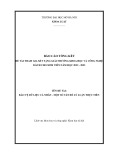
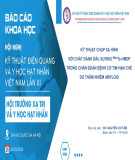

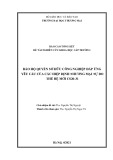
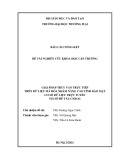
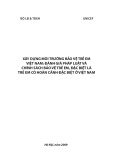
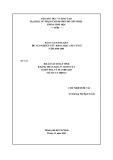
![Vaccine và ứng dụng: Bài tiểu luận [chuẩn SEO]](https://cdn.tailieu.vn/images/document/thumbnail/2016/20160519/3008140018/135x160/652005293.jpg)
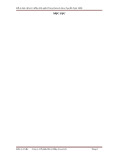
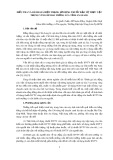





![Báo cáo seminar chuyên ngành Công nghệ hóa học và thực phẩm [Mới nhất]](https://cdn.tailieu.vn/images/document/thumbnail/2025/20250711/hienkelvinzoi@gmail.com/135x160/47051752458701.jpg)









